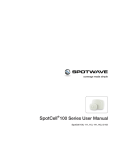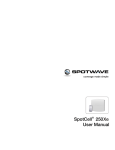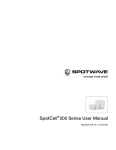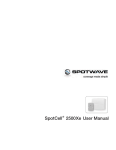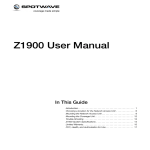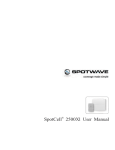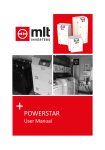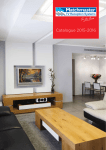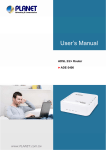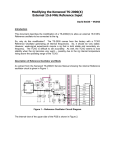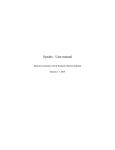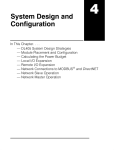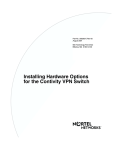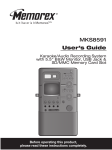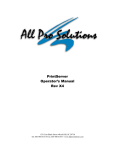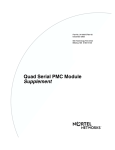Download SpotCell® 167/267 User Manual
Transcript
®
SpotCell 100 Series User Manual
SpotCell 100, 111, 112, 141, 142, 163, & 167
Technical Support
SpotCellTM serial numbers must be available to authorize technical support and/or to establish a
return authorization for defective units. The serial numbers are located on the back of the Coverage
Unit (CU) and the Donor Unit (DU), as well as on the box in which they were delivered. Additional
support information may be obtained by accessing the Spotwave Wireless Inc. website at
www.spotwave.com. To contact support by telephone, call your local Spotwave vendor; or if you
are unable to reach your vendor, contact Spotwave Wireless at 1-877-610-9586.
Important Safety Information
Warning! For your safety, beware of power lines and ensure appropriate safety measures are
maintained at all times during the installation of the SpotCell equipment. If equipment not shipped
with the SpotCell system is to be used during installation or mounting, follow all equipment
manufacturer’s instructions in proper use to ensure injury is avoided.
The DU and CU of the SpotCell are low power transmitters. As with a cell phone antenna, avoid
unneccessary contact with the front of the units when they units are operating. Mount the units in a
location where people will not approach within 1 meter of the front of the DU and 20 centimeters in
front of the CU.
When deploying the extended coverage antenna, there must be a minimum separation of 10 cm
between the main CU and the extended coverage antenna with the antennas facing in opposite
directions. The extended coverage antenna should be mounted in locations where people will not
approach within 20 cm in front of the antenna
This manual outlines installation instructions and the appendix offers practical safety tips (see
Appendix E entitled ‘Safety Hints’).
If you are not sure about a safe installation, do not attempt to install it yourself. Call a professional
installer for help.
LIMITED WARRANTY AND LIMITATION OF LIABILITY:
1. What is Covered and for How Long?
Spotwave Wireless Inc. ("Spotwave") warrants to the original Purchaser that the Spotwave SpotCell System (the
"System") is free from defects in material and workmanship under normal use and service for a period of 12 months from the date of shipment from Spotwave
(the "Limited Warranty Period").
2. What is not covered?
This Limited Warranty is conditioned upon proper use of the System by the Purchaser. This Limited Warranty does not cover (and
will become null and void in the event of): (a) defects or damage resulting from accident, misuse, abuse, neglect, unusual physical, electrical or
electromechanical stress, modification of the System or any part thereof, or cosmetic damage; (b) removal, alteration or defacing of the serial number or other
identifying marks on the System; (c) all plastic surfaces and other externally exposed components that are scratched or damaged due to normal use; (d)
malfunctions resulting from the use of the System in conjunction with accessories, products or (ancillary) or peripheral equipment not provided by Spotwave;
or (e) defects or damage from unauthorized or improper testing, operation, maintenance, installation, servicing or adjustment of the System. Any repairs or
replacements provided by Spotwave outside of the Limited Warranty Period (including repairs to or replacement after the end of the Warranty Period), or in
excess of the services provided during the Limited Warranty Period, will subject to Spotwave's then prevailing rates.
3. What are Spotwave's Obligations and how do you make a claim? During the Limited Warranty Period, Spotwave will repair or replace, at Spotwave's sole
option, without charge to Purchaser, any defective component of the System, provided that the System is returned promptly upon discovery of the defect
and during the Limited Warranty Period. To obtain service, Systems must be returned to an authorized service facility in the original packaging or packaging
adequate for shipping, accompanied by Purchaser's sales receipt or comparable substitute proof of sale showing the date of purchase and the serial number
of the System. A valid RMA is required prior to any return.
To locate your nearest authorized service facility, call Spotwave Customer Service at 1-877-610-9586. Spotwave may, at Spotwave's sole option, use rebuilt,
reconditioned, or new parts or components when repairing any System or replace a System with a rebuilt, reconditioned or new System. Repaired Systems
LIMITED WARRANTY AND LIMITATION OF LIABILITY:
will be warranted for a period equal to the remainder of the original Limited Warranty Period for the original System or for 90 days,
whichever is longer. All replaced parts, components, boards or equipment shall become the property of Spotwave. If Spotwave
determines that any System is not covered by this Limited Warranty, Purchaser must pay the costs for all parts, shipping, and labor charges
for the repair or return of such System.
4. What are the Limits on Spotwave's Liability?
EXCEPT FOR THE WARRANTY IN PARAGRAPH 1, THE SYSTEMS AND ANY
ASSOCIATED SERVICES ARE PROVIDED BY SPOTWAVE ON AS 'AS IS' BASIS AND THERE ARE NO OTHER REPRESENTATIONS,
WARRANTIES OR CONDITIONS, EXPRESS OR IMPLIED, WRITTEN OR ORAL, ARISING BY STATUTE, OPERATION OF LAW, COURSE
OF DEALING, USAGE OF TRADE OR OTHERWISE, REGARDING THEM OR ANY OTHER PRODUCT OR SERVICE PROVIDED
HEREUNDER OR IN CONNECTION HEREWITH BY SPOTWAVE. SPOTWAVE DISCLAIMS ANY IMPLIED WARRANTIES OR CONDITIONS
OF DURABILITY, MERCHANT ABILITY, MERCHANTABLE QUALITY, SATISFACTORY QUALITY, NON-INFRINGEMENT OR FITNESS FOR
A PARTICULAR PURPOSE. SPOTWAVE DOES NOT REPRESENT OR WARRANT THAT THE SYSTEMS WILL MEET ANY OR ALL OF
PURCHASERS' PARTICULAR REQUIREMENTS, THAT THE SYSTEMS WILL OPERATE ERROR-FREE OR UNINTERRUPTED OR THAT
ALL ERRORS OR DEFECTS IN THE SYSTEMS CAN BE FOUND TO BE CORRECTED. System performance is dependant upon the
performance and availability of services or technology provided by third parties and Spotwave is not responsible for service continuity and
reliability, reception, or other performance related limitations associated with use of the Systems. NO AGREEMENTS VARYING OR
EXTENDING THE TERMS OF THIS LIMITED WARRANTY WILL BE BINDING ON SPOTWAVE UNLESS IN WRITING AND SIGNED BY AN
AUTHORIZED SIGNING OFFICER OF SPOTWAVE THIS LIMITED WARRANTY SHALL NOT EXTEND TO ANYONE OTHER THAN THE
ORIGINAL PURCHASER OF THE SYSTEM. SPOTWAVE'S MAXIMUM AGGREGATE LIABILITY TO PURCHASER SHALL NOT EXCEED
THE AMOUNTS PAID BY PURCHASER FOR THE SYSTEM GIVING RISE TO THE CLAIM. SPOTWAVE SHALL NOT BE LIABLE FOR ANY
SPECIAL, INCIDENTAL, CONSEQUENTIAL, INDIRECT OR SIMILAR DAMAGES, LOSS OF USE, DATA OR PROFITS, DAMAGES TO
PURCHASER'S PROPERTY, OR INJURY TO PURCHASER OR OTHERS ARISING OUT OF THE USE, MISUSE OR INABILITY TO USE
ANY SYSTEM, WHETHER OR NOT SUCH DAMAGE ARISES OUT OF CONTRACT OR TORT (INCLUDING WITHOUT LIMITATION,
NEGLIGENCE) OR CLAIMS BY A THIRD PARTY, EVEN IF SPOTWAVE HAS BEEN ADVISED OF SUCH DAMAGES OR THEY ARE
FORESEEABLE
5. This Limited Warranty allocates risk between Purchaser and Spotwave, and the Spotwave System pricing reflects this allocation of risk
and the limitations of liability contained in this Limited Warranty. The agents, employees, distributors, dealers or representative of Spotwave
are not authorized to make modifications to this Limited Warranty, or make additional warranties binding on Spotwave. Accordingly,
additional statements such as advertising or presentations, whether oral or written, do not constitute warranties by Spotwave and should
not be relied upon.
OWNERSHIP AND RISK OF LOSS:
6. Who Owns the rights in the System?
The System is protected by Canadian, US and international copyright law and other intellectual
property protection laws and treaties. Purchaser acknowledges that Spotwave and its licensors are the owner of all intellectual property,
including, without limitation, patents and copyright,
relating to the System and the trademarks used in association with the System. Purchaser agrees that it will not (and will not attempt to)
modify, prepare derivative works of, reverse engineer, decompile, disassemble, or other attempt to derive the source code of any software
contained within the System.
7. Who bears the Risk of Loss?
Risk of loss for the System passes to Purchaser upon the delivery to Purchaser or to a carrier for
shipment, which ever is earlier. Title to the Systems (excluding any software) will pass upon payment in full for the Systems. Title to any
software shall always remain with Spotwave or its licensors. As security for payment, Purchaser grants to Spotwave a purchase money
security interest in the Systems (together with any proceeds, including insurance proceeds) and agrees that a copy of this letter of
agreement or any other appropriate document may be registered as required to perfect the security interest granted. Systems may be
resold by Purchaser in normal course of business, but until paid for in full, Purchaser will not pledge or otherwise encumber the Systems.
Purchaser agrees to immediately report to Spotwave, any seizure or attachment of the Systems by creditors; (ii) any petition in bankruptcy,
insolvency, receivership or similar proceedings filed by, or against Purchaser; or (iii) any arrangement, composition or similar agreement for
the benefit of creditors. Systems held for Purchaser by Spotwave are at Purchaser's sole risk and expense.
OTHER TERMS:
8. What terms govern our relationship?
These terms and any software license or warranty documentation accompanying the Systems
constitute the complete and exclusive statement of the terms and conditions between us regarding the Systems and cannot be altered,
amended or modified except in writing executed by Spotwave. This letter of agreement and any disputes arising hereunder shall be
governed by and interpreted in accordance with the laws of the Province of Ontario, Canada. The United Nations Convention on Contracts
for the International Sale of Goods and any legislation implementing such Convention, if otherwise applicable is expressly excluded. Any
terms and conditions of any purchase order or other instrument issued by Purchaser which are in addition to or inconsistent with the terms
and conditions of this letter of agreement shall not be binding and shall not apply, even if accepted by Spotwave.
MANUAL DISCLAIMER
Product specifications, pricing, packaging, technical support and information ("Specifications") and all claims, features, representations,
and/or comparisons provided are correct to the best of our knowledge of the date of publication, but may contain errors or omissions and
are subject to change without notice.
INFORMATION IS PROVIDED BY SPOTWAVE WIRELESS INC. ON AN "AS IS" BASIS, WITHOUT ANY OTHER WARRANTIES OR
CONDITIONS, EXPRESS OR IMPLIED, INCLUDING, BUT NOT LIMITED TO, WARRANTIES OF MERCHANTABLE QUALITY,
SATISFACTORY QUALITY, MERCHANTABILITY OR FITNESS FOR A PARTICULAR PURPOSE, OR THOSE ARISING BY LAW, STATUTE,
USAGE OF TRADE, COURSE OF DEALING OR OTHERWISE. THE ENTIRE RISK AS TO THE RESULTS OF THE INFORMATION
PROVIDED IS ASSUMED BY YOU. WE SHALL HAVE NO LIABILITY TO YOU OR ANY OTHER PERSON OR ENTITY FOR ANY INDIRECT,
INCIDENTAL, SPECIAL, OR CONSEQUENTIAL DAMAGES WHATSOEVER, INCLUDING, BUT NOT LIMITED TO, LOSS OF REVENUE OR
PROFIT, LOST OR DAMAGED DATA OR OTHER COMMERCIAL OR ECONOMIC LOSS, EVEN IF WE HAVE BEEN ADVISED OF THE
POSSIBILITY OF SUCH DAMAGES, OR THEY ARE FORESEEABLE. WE ARE ALSO NOT RESPONSIBLE FOR CLAIMS BY A THIRD
PARTY. OUR MAXIMUM AGGREGATE LIABILITY TO YOU AND THAT OF OUR DEALERS AND SUPPLIERS SHALL NOT EXCEED
FOURTY DOLLARS.
SOME STATES/COUNTRIES DO NOT ALLOW THE EXCLUSION OR LIMITATION OF LIABILITY FOR
CONSEQUENTIAL OR INCIDENTAL DAMAGES, SO THE ABOVE LIMITATIONS MAY NOT APPLY TO YOU. All product, font and company
names are trademarks or registered trademarks of their respective owners.
ii
SpotCell® 100 Series
Table of Contents
Introduction . . . . . . . . . . . . . . . . . . . . . . . . . . . . . . . . 1
Getting Started . . . . . . . . . . . . . . . . . . . . . . . . . . . . . . 3
Packing List . . . . . . . . . . . . . . . . . . . . . . . . . . . . . 3
Installation . . . . . . . . . . . . . . . . . . . . . . . . . . . . . . . . . 5
Preparation . . . . . . . . . . . . . . . . . . . . . . . . . . . . . . 5
Positioning the DU . . . . . . . . . . . . . . . . . . . . . . . . 6
Choosing a location for the SpotCell CU . . . . . . . 11
Positioning the CU . . . . . . . . . . . . . . . . . . . . . . . 12
Auxiliary Antenna . . . . . . . . . . . . . . . . . . . . . . . . . 12
Mounting the DU and CU . . . . . . . . . . . . . . . . . . . . . 13
Running Cable Through Walls . . . . . . . . . . . . . . . 13
Mounting the DU . . . . . . . . . . . . . . . . . . . . . . . . . 13
DU Outdoor Mounting . . . . . . . . . . . . . . . . . . . . . 15
DU indoor mounting . . . . . . . . . . . . . . . . . . . . . . 18
Mounting the CU . . . . . . . . . . . . . . . . . . . . . . . . . 18
Display Information . . . . . . . . . . . . . . . . . . . . . . . . . . 21
DU LED Color . . . . . . . . . . . . . . . . . . . . . . . . . . . 21
CU LED Color . . . . . . . . . . . . . . . . . . . . . . . . . . . 21
Trouble-Shooting . . . . . . . . . . . . . . . . . . . . . . . . . . . 25
SpotCell 100 System Specifications . . . . . . . . . . . . . 29
SpotCell 111/112 System Specifications . . . . . . . . . 33
SpotCell 163 System Specifications . . . . . . . . . . . . . 37
SpotCell 167 System Specifications . . . . . . . . . . . . . 41
SpotCell 141/142 System Specifications . . . . . . . . . 45
Safety Hints . . . . . . . . . . . . . . . . . . . . . . . . . . . . . . . 49
SpotCell 100 Series
iii
iv
SpotCell 100 Series
1 – Introduction
1.1 This Manual
The contents of this manual complements the Quick Install Guide. It provides specific
details that may be referred to if necessary during installation of a SpotCell™ 100 Series
adaptive coverage system.
1.2 No Special Knowledge
Installation of a SpotCell solution does not require any specialized technical knowledge.
The SpotCell coverage system can be installed by any person(s) with the ability to use a
screwdriver, and in some situations may require the use of a ladder, drill, and additional
related tools.
1.3 Product Overview
The purpose of the SpotCell system is to enable personal wireless communications in
specific locations within a wireless service area where cell phones do not work, or work
poorly, for example inside a building, or at the cell boundary.
The SpotCell system receives signals from one or more wireless base stations and retransmits the signal to areas where cell phones do not work or work poorly due to
obstructions or the remoteness of the location.
Spotwave Wireless Inc.
1
INTRODUCTION
Figure 1.1: Base station signal does not reach wireless subscriber
Figure 1.2: SpotCell improves wireless communications
The SpotCell™ 100 Series adaptive coverage system provides band-selective, onfrequency, in-building coverage in the cellular, PCS or SMR bands. It uses proprietary,
patent-pending, adaptive techniques that allow a SpotCell solution to be installed and
operated without engineering intervention or support.
The SpotCell solution is generally format specific - AMPS, CDMA/1xRTT/1xEVDO,
TDMA/GSM/GPRS/EDGE, and iDEN formats. When ordering a SpotCell solution be
sure to specify the format, frequency band and sub-band. For PCS band equipment it is
helpful if the start and stop frequencies for the operational sub-band are provided.
2
SpotCell® 100 Series
2 – Getting Started
2.1 Packing List
The SpotCell solution is shipped in a single box containing:
Donor Unit (DU) - this is the outward facing part of the system.
Coverage Unit (CU) - this is the indoor part of the system.
Power Adapter - to be plugged into an electrical outlet, and connected to the CU.
Cable - used to connect the CU and DU together.
Mounting Kit
SpotCell 141/142 : The SpotCell 141 and SpotCell 142 Dual Band systems include a
second DU and extra cables to connect the two DUs.
DU
CU
Cable
Power
Adapter
Figure 2.1: Components of the SpotCell package
Spotwave Wireless Inc.
3
GETTING STARTED
Note: Parts are provided for the majority of installation options, but do not cover all
possibilities. You may need to purchase additional hardware specific to your mounting
environment before you begin the installation. A tripod and mast would be typical
additional equipment purchased for mounting the SpotCell DU on a rooftop.
Cables
DUs
CU
Figure 2.2: Components of SpotCell 141/142 Dual Band package
2.2 Unpacking
Physically inspect the box for shipping damage before unpacking the SpotCell System.
1. Remove the SpotCell components from the box.
2. Remove all packing material from the Donor Unit (DU) and the Coverage Unit (CU).
Save the packaging in case the SpotCell System is ever stored or shipped to
SpotWave for service.
3. Check the contents of the package to make sure you have received everything
ordered and verify that the mounting kit contains all the listed parts.
4. Check the DU and CU for shipping damage. Pay particular attention to the unit’s
outer shell casing.
4
SpotCell® 100 Series
3 – Installation
3.1 Preparation
The following are general considerations and preparations that should be looked at
before installing the SpotCell system.
3.1.1 Signal Strength
The SpotCell system brings signals from an area of adequate coverage to an area with
poor or non-existent coverage. It is the DU which captures a good signal, and the CU
that provides the signal to the area with poor cell phone coverage. The DU can be
mounted inside or outside, as long as it is in an area where your cell phone works.
Generally, the better your cell phone works at the location the DU is mounted, the better
the system will perform.
3.1.2 DU Height
In fringe areas, locating the DU as high as possible will provide optimal performance.
3.1.3 Avoid obstructions
General placement of the DU and CU must be in unobstructed areas. For example, the
CU should not be placed on a wall behind any type of furniture (behind items such as
metal filing cabinets would be a particularly poor location). Similarly for the DU, the front
of the unit should not be directly facing any type of metal structures, which are often
found on building rooftops.
3.1.4 Proximity to power source
The indoor unit (CU) must be located within 20 feet (6 meters) of a power source.
Spotwave Wireless Inc.
5
INSTALLATION
3.1.5 Distance between DU and CU
Although you should separate the DU and CU as much as possible, there are only 82
feet (25 meters) of cable (see following note) provided to connect the two units. Make
sure the general location of the two units is within this limit. The standard cable is quadshield RG-6. Use only Spotwave Wireless supplied cable.
Note:
1. For greater DU to CU separations RG-11 quad shield cable can be ordered.
This extends the DU to CU distance to 164 feet (50 meters).
2. Plenum rated RG-6 and RG-11 cable may be ordered.
Plenum cable is needed for installations in return air ceilings, floor to floor riser use
and elevator shafts.
3.1.6 Orientation of DU relative to CU
If possible face the DU and CU in opposite directions, and back to back while
maintaining maximum separation. While not a requirement, some installations will
perform better if the units are positioned in this manner. This is generally more important
for an inside mounted DU than one mounted outside on a roof or an external wall.
3.1.7 Barrier between DU and CU
The greater the physical obstruction between the DU and CU, the better the
performance. Dense obstructions such as brick, concrete or metal walls are better than
wooden or plaster walls.
3.2 Positioning the DU
The DU is the outward facing unit. It is the unit that picks up the signal from and
communicates with the service providers basestation network.
It may not be possible to install the DU indoors when installing the SpotCell solution in
remote areas. An effort should be made to install the DU outdoors and the DU should be
installed as high as possible when the installation is in a remote area.
Use your mobile phone handset to identify the inside location where the strongest signal
is received, or the outside roof or external wall location where the strongest signal is.
6
SpotCell® 100 Series
INSTALLATION
3.2.1 Installing the DU
The following outlines the procedure for locating a DU inside a building, on a rooftop,
and on the outside surface of an external wall.
1. Position the DU (but do not mount it) as close to the final desired mounting location
as possible. It is helpful to have the CU near the DU. The CU does not have to be in
its final location at this time.
Indoors
While not a requirement, it is highly
recommended the DU be installed
facing a windowa when installed
indoors.
Outside on a Roof
Outside on an External
Wall
The CU does not have to be in its final
position at this time, but it should not be
brought outdoors if it is raining, below
freezing or above 105 Fo (40 Co).
a. Tinted windows may contain metallic particles which can degrade the radio signal more than
the adjacent exterior wall.
2. For dual band systems (SC141/142):
a) Connect a 6 foot (2 meter) RG6 cable to the CU.
b) Connect the other end of the RG6 cable to the RG11 cable using the provided
adapter.
c) Connect the RG11 cable to the upper connector on the PCS DU
Figure 3.1: Connecting SC141/142 CU to PCS DU
SpotCell® 100 Series
7
INSTALLATION
d) Use the remaining RG6 cable to connect the PCS DU to the Cell DU.
Figure 3.2: Connecting SC141/142 PCS DU to Cell DU
For all other (non dual band) systems:
a) Connect the DU and CU with the enclosed cable.
Figure 3.3: Connecting CU to DU
3. Tighten all cable connections to the DUs and CU with a wrench (a 1/4 of a turn
tighter than finger tight) to ensure moisture does not penetrate.
4. Connect the power supply as shown below.
Figure 3.4: Connecting power supply to CU
8
SpotCell® 100 Series
INSTALLATION
Note: Only use the power supply provided with the SpotCell system. Connecting a power supply
from another SpotCell system may damage the unit and cause it to fail.
5. Ensure the mode switch on the CU is in the ‘Install’ (1) position.
For dual band systems (SC141/SC142) set the band select switch to 800 MHZ.
mode
switch
band
select
switch
Figure 3.5: CU witch locations
6. Plug the power supply adapter into a wall socket.
7.
Alignment Step 1. Hold the DU upright and pointing away from you. If installing a dual band system
(SC141/142), ensure you are holding the 800 MHZ DU.
Ignore the color of the LED on the back of the DU, while:
Indoor DU
Outdoor DU On a Roof
Outdoor DU on an External
Wall
Rotating the DU left to right
with the DU facing to the
outside through the window.
Rotating the DU in a
complete 360° circle.
Rotating the DU left to
right with the DU facing
away from the exterior
wall.
Exterior Wall
Window or
Exterior Wall
If not in front of a window,
rotate the DU in a complete
360° circle (see roof location
diagram).
163 iDEN & 167 Product Only. For the 163 & 167 products, the LED on the DU flashes.
When rotating the DU from time to time the flashing will stop and the LED turns OFF,
when this occurs momentarily pause the rotation then resume when flashing restarts.
SpotCell® 100 Series
9
INSTALLATION
8. Alignment Step 2. Repeat the above rotation a second time. This time monitor the
color of the LED. The LED color is an indication of the signal strength the DU is
receiving from the wireless basestation tower.
Stop the rotation each time the LED is green and note the direction the DU is facing
when it is GREEN (the LED may turn green once or multiple times). The GREEN
direction is the direction the DU must face when installed for best system
performance.
When multiple GREEN locations are present mount the DU facing the direction
where the LED was green for the longest period of time during this second rotation.
9. For dual band systems (SC141/142) set the band select switch to 1900 MHZ and,
with the 1900 MHZ DU, repeat steps 7 and 8 to align the second DU.
10. It is recommended that various outside roof and exterior wall locations, and locations
within the building be tested to identify the best DU location. The LCD display on the
DU will help you identify the location where the signal strength is strongest. The LCD
display on the CU indicates the signal strength that the DU is receiving. figure 3.6
shows 5 bars of signal strength. Five bars is maximum.
Figure 3.6: Displayed signal strength
Mount the DU in the location that has the highest indicated signal level. Then aim the
DU in the direction that provides the highest indicated signal level on the CU LCD
display.
Note: On the upper floors of tall buildings, it may be necessary to tilt the DU down to get the
strongest signal.
11. Proceed to Chapter for mounting instructions once the DU location has been
optimized.
10
SpotCell® 100 Series
INSTALLATION
3.3 Choosing a location for the SpotCell CU
The CU location is optimized, after the DU location and orientation has been optimized
and the DU has been mounted.
Generally, the CU should be mounted in a location as far as possible from the DU, while
being within the area where you require improved coverage.
If mounted on a ceiling, the unit should be facing downward, and in the center of the
area requiring coverage. When mounted facing down (horizontal) the coverage pattern is
circular for an open are with minimum obstructing walls. When mounting the CU
horizontally place it in the centre of the area needing improved coverage.
SC141/142 Note: The dual band CU should only be mounted vertically.
1/3
2/3
Interior Wall
Figure 3.7: CU position and signal coverage
If mounted vertically on a wall, facing away from the wall the coverage pattern for an
open area with minimum obstructing walls is as shown in figure 3.7.
When mounting the CU vertically the unit should be positioned in the middle of the area
to be covered side-to-side, and off-centered front-to-back, as shown in figure 3.7. The
coverage area to the front is about twice that to the back of the CU if the wall it is
mounted on is a typical interior drywall partition wall, and not one constructed of a dense
material such as concrete. The unit should be mounted as high on the wall as possible.
Alternatively the CU can be mounted vertically by suspending it from the t-bars of a
suspended ceiling. T-bar clips are commercially available that permit this.
SpotCell® 100 Series
11
INSTALLATION
3.4 Positioning the CU
1. Ensure that the DU position has been optimized and has been mounted in place.
2. Move the mode switch on the CU from ‘Install’ to ‘Active’.
3. Hold the CU in the position it is to be mounted. Ideally the display on the CU will
show 5 bars for coverage area.
If it is not showing 5 bars for coverage area and there are alternate mounting
locations, move the CU to the alternate locations and check the display. Place the
CU in the location showing maximum number of bars.
Note: Each time the CU is moved, wait approximately 25 seconds for the coverage area bars
(
) to stabilize.
4. If the number of bars is not changing, which is very possible, choose a CU mounting
location that is convenient for the area requiring coverage.
5. Refer to Chapter for mounting instructions.
3.5 Auxiliary Antenna
The SpotCell Coverage Extension kit (purchased separately) can extend coverage into
hard to reach places that are blocked by obstructions such as dense walls or shadowed
by elevator shafts or ductwork.
Auxiliary
antenna
connection
Instructions for connecting and mounting the auxiliary antenna are included in the
Coverage Extension (CE) kit. A CE will provide coverage for an area about 25% of that
provided by the CU.
12
SpotCell® 100 Series
4 – Mounting the DU and CU
4.1 Running Cable Through Walls
If it is necessary to run a cable through a wall, use a masonry or wood drill bit to drill a
3/4-inch diameter hole.
After passing the cable through, use the putty in the installation kit to fill the hole around
the cable.
4.2 Mounting the DU
The DU (or two DUs for dual band SC141/142 systems) may be indoor or outdoor
mounted. Based on the direction the DU will point, consider possible mounting
locations.
All necessary hardware required for mounting on internal or external walls, or on pipes is
included in the mounting kit.
The illustrations on the following pages show some of the possible mounting options.
4.2.1 Wall Mount
Figure 4.1: Wall Mount
Upper circular slot
The mounting shown in Figure 4.1: allows for no
significant left or right rotation, but provides a wide
range of down-tilt when the lower circular slot on the
angle backplate is used, a wide range of up-tilt when the
upper circular slot is used, but no up-tilt or down-tilt
when the center hole on the backplate is used (the
center hole is hidden from view in Figure 4.1:).
Lower circular slot
Spotwave Wireless Inc.
13
MOUNTING THE DU AND CU
4.2.2 Overhead Mount
Figure 4.2: Overhead Mount
The mounting shown in Figure 4.2: provides
left to right rotation, and a wide range of
down-tilt using the upper circular slot or a
small amount of up-tilt and down-tilt when the
bottom circular slot is used.
4.2.3 Horizontal Surface Mount
Figure 4.3: Horizontal Surface Mount
The mounting shown in Figure 4.3: allows for
left to right rotation and a wide range of
upward tilt using the lower circular slot, or a
small amount of down tilt and down tilt when
the upper circular slot is used.
4.2.4 Pipe Mount
Figure 4.4: Pipe Mount
Use hose clamps to mount the unit to a 2-in to
5-in pipe.
The mounting shown in Figure 4.4: allows for
complete left to right rotation with a limited
range of up-tilt or down-tilt.
If the hose clamp bracket is reversed to extend
down then the up-tilt range will increase if the
DU is mounted at the top of the pipe, but the
down-tilt range is unchanged.
14
SpotCell® 100 Series
MOUNTING THE DU AND CU
4.3 DU Outdoor Mounting
The mounting bracket has 4 mounting holes for 1/4-in lag bolts. Three are in a triangular
pattern, the fourth is a circular slot. Only the circular slot and one other hole is shown in
the previously given figures.
4.3.1 Mounting to a wood structure
1. Use the holes in mounting bracket as a template and mark the hole locations. Mark
two regular holes if no motion is required or one hole and the circular slot if motion is
required for optimizing the orientation of the DU.
2. Drill two 1/8-in. diameter holes approximately 2.5-in. deep.
3. Install the DU using the two 1/4-in. lag bolts.
4. If additional security is required a third hole and lag bolt could be used after correct
orientation is determined.
4.3.2 Mounting to a brick or concrete structure:
1. Use holes in mounting bracket as a template and mark the hole locations. Mark the
2.
3.
4.
5.
two regular holes if no motion is required or the hole and slot if motion is required.
Use a masonry drill bit to drill two 5/16-in. diameter holes, 2-in. deep.
Insert masonry screw anchors so that the anchor is flush to the mounting surface.
Install the DU using the two 1/4" lag bolts.
If additional security is required a third hole and lag bolt could be used after correct
orientation is determined.
4.3.3 Mounting to a pipe:
Use the supplied two stainless steel hose clamps.
1. Feed the end of the hose clamp through the rectangular slots as shown in Figure
4.4: "Pipe Mount".
2. Aim the DU at the signal source and tighten clamps.
Note: DO NOT use cable ties to mount the DU.
4.3.4 Attaching the cable
Figure 4.5: Drip Loop
While securing the cable, ensure that a drip
loop is fashioned near the DU (to prevent
water from collecting around the cable where it
attaches to the DU).
Fashion the drip loop and fasten a black tie
wrap around the loop to keep the loop
secured as shown in Figure 4.5: "Drip Loop".
SpotCell® 100 Series
15
MOUNTING THE DU AND CU
shows drip loops secured for both cables near the dual band (SC141/142) PCS DU.
Figure 4.6: Drip Loops for dual band PCS DU
When routing the cable on a roof be sure to locate it where it will not be tripped over.
Use tie-wraps to attach the cable to an existing pipe or cable run.
Figure 4.7: Cable Strap
Secure the cable to wood or siding walls using #6 x 1.5-in. wood screws and cable loop
straps as shown in Figure 4.7:.
To attach the cable to a brick or concrete wall:
1. Drill a 3/16-in. diameter x 1-1/4 in. deep hole using a masonry drill bit.
2. Insert the anchor flush with the mounting surface.
3. Use cable clamps and screws to attach the cable to the wall.
4.3.5 Bringing the cable indoors
To bring the cable indoors, it may be necessary to drill a hole through the wall.
To bring the cable through an exterior wall:
1. Depending on the material the wall is made of use a wood or masonry drill bit to drill
a 3/4-in. diameter hole.
2. Pass the connector and cable through the wall.
3. Use the putty/sealant provided to fill the hole.
16
SpotCell® 100 Series
MOUNTING THE DU AND CU
4.3.6 DU Grounding (outside DU only)
When the DU is installed outside electrical (or building)
code calls for the DU to be grounded. A ground-stud is
provided on the back of the DU for this - see Figure 4.8:.
Ensure there is a connection to earth ground.
Figure 4.8: DU Ground Stud
When grounding the DU, use #10-AWG solid-copper
wire (minimum). Green insulation is preferred.
Ground Stud
Alternatively uninsulated #8-AWG aluminum may be
permitted. Be sure to check national and local code requirements.
Connect the ground wire to the DU ground terminal using a crimp-on ring or lug
connector. Ground conductor and termination hardware are not supplied.
Warning! Failure to properly ground the DU will leave the unit and building vulnerable to
damage from lightning strikes. Check local building and electrical code requirements and
comply with both local and national regulations.
Ideally the DU ground wire should be bonded to the roof ground network. For roofs
without such a network use a metal cold water pipe, structural steel, or metal conduit.
4.3.7 Cable Grounding (outside DU only)
When the DU is installed outside electrical (or building)
code calls for the outer conductor of the coaxial cable to
be grounded at or near the point of entrance of the
cable into the building. A ground-block (not supplied) is
required for this - see Figure 4.9:.
Figure 4.9: Ground Block
Ideally the ground block should be bonded to the roof
ground network, a metal cold water pipe, structural
steel, or metal electrical conduit. Use #10-AWG solid-copper wire (minimum).
Connect the ground wire to the cold water pipe or alternative using an appropriate
crimp-on ring or lug connector. Ground conductor and termination hardware are not
supplied.
SpotCell® 100 Series
17
MOUNTING THE DU AND CU
4.4 DU indoor mounting
To mount the DU indoors:
1. Use the mounting bracket as a template and mark the hole locations. Mark the two
regular holes if no motion is required or mark the hole and the slot if motion is
required.
2. If the mounting is in a solid wood surface, or a stud covered by drywall, drill a 5/32
inch diameter hole. Mount the unit with 2 inch wood screws.
or
If the mounting is in drywall, drill a ¼ diameter hole and insert an anchor. Mount the
unit with 1/2 inch pan head screws.
3. Attach cables to the wall using tie wraps and mount directly to the wall where
possible (using 1/2 inch pan head screws). If an anchor is required drill a 3/16 inch
diameter hole, insert the anchor, and fasten with 1/2 inch pan head screws.
4.5 Mounting the CU
The SpotCell 100 series of products have two
different types of mounting systems.
The dual band product (SC141/142) uses a
mounting clip that is attached to the wall. The clip
must be mounted at least 4 inches from the ceiling
to allow the CU to slip into the bracket.
Figure 4.10: SC141/142
CU mounting bracket
All other SpotCell 1xx systems can either be
surface mounted flat or can be attached using the
optional ball bracket. The ball bracket can be
rotated to allow mounting to a ceiling or wall such
that the face of the unit is parallel to the floor or
ceiling, or positioned at any appropriate angle.
CU bracket
Figure 4.11: CU mounting bracket.
18
SpotCell® 100 Series
MOUNTING THE DU AND CU
Mounting the dual band (SC14x) CU
1. Find a suitable location to mount the unit that will provide good signal coverage.
Refer to section 3.3 "Choosing a location for the SpotCell CU".
2. Fasten the mounting bracket insert to the back of the CU.
Figure 4.12: Fasten mounting bracket insert to
SC141/142 CU
3. If mounting on a solid wood surface, or stud covered by drywall, drill a 1/8th inch
diameter hole at least 4.5 inches from the ceiling (to allow the CU to slip into the
bracket) and then fasten the mounting clip with #6 x 1.5” screws.
or
If mounting in drywall, drill a ¼ inch diameter hole at least 4.5 inches from the ceiling
(to allow the CU to slip into the bracket), insert the screw anchors, and then fasten
the mounting clip with 1/2” screws.
4. Mount the CU by sliding the insert into the bracket.
5. Attach cables to the wall using tie wraps and mount directly to the wall where
possible (using 1/2 inch pan head screws). If an anchor is required drill a 3/16 inch
diameter hole, insert the anchor, and fasten with 1/2 inch screws.
Mounting other (non dual band) CUs
1. Find a suitable location to mount the unit that will provide good signal coverage.
Refer to section 3.3 "Choosing a location for the SpotCell CU".
2. If mounting on a solid wood surface, or stud covered by drywall, drill a 1/8th inch
diameter hole and mount with #6 x 1.5” screws.
or
If mounting in drywall, drill a ¼ inch diameter hole, insert the screw anchor, and then
mount with a 1/2” pan head screw.
3. Attach cables to the wall using tie wraps and mount directly to the wall where
possible (using 1/2 inch pan head screws). If an anchor is required drill a 3/16 inch
diameter hole, insert the anchor, and fasten with 1/2 inch screws.
SpotCell® 100 Series
19
MOUNTING THE DU AND CU
20
SpotCell® 100 Series
5 – Display Information
5.1 DU LED Color - 2nd Rotation
Figure 5.1: LED on back of DU
DU LED
LED is RED: The DU is either not capturing an adequate
signal for the system to operate, or capturing one that is
too strong for the system (rarely the case).
LED is YELLOW: The captured signal is within range and
the system will function, but it is not the strongest signal
available at the present location.
LED is GREEN: The DU is capturing a signal that is either
the strongest one available at the present location, or
nearly so.
5.2 CU LED Color
Figure 5.2: CU LED
OFF = NO Power
RED = Power + Install Mode
or
RED = Power + Active Mode + Alarm
GREEN = Power + Active Mode + NO Alarm
CU
LED
Spotwave Wireless Inc.
21
DISPLAY INFORMATION
5.2.1 LCD
The CU LCD displays system status and signal strength. The signal strength is indicated
by the signal strength bars (
) and the coverage strength is indicated by the coverage
bars (
).
The following table shows the various messages displayed and if necessary, what action
should be taken.
Display with alternating display (if present)
Action (if required)
Initializing.
No action required.
System is not
optimally positioned.
Turn the DU to
another appropriate
position.
System will not
function.
Turn the DU to
another appropriate
position.
Turn the DU to
another appropriate
position.
Check the RF cable
and verify that it is
connected properly.
Make sure the length
of the RF cable is less
than 75 meters.
Call product support.
Telephone #:
1-877-610-9586
Table 1: CU Display States
22
SpotCell® 100 Series
DISPLAY INFORMATION
Display with alternating display (if present)
Action (if required)
All OK.
No action required.
Signal weak, but
working.
No action required.
Turn the DU to
another appropriate
position.
Move the CU to an
alternate location,
preferable farther
away from the DU.
Move the CU to an
alternate location,
preferable farther
away from the DU.
Temporary loss of
service.
No action required
Loss of service for
more than 24 hours.
Turn the DU to
another appropriate
position.
Table 1: CU Display States
SpotCell® 100 Series
23
DISPLAY INFORMATION
The following table shows how dual band (SC141/142) differs from the other SpotCell
systems.
Display with alternating display (if present)
Action (if required)
All OK.
The C or P in the
upper right indicates
the position of the
band select switch on
the dual band CU.
No action required.
Table 2: Dual band messages
24
SpotCell® 100 Series
6 – Trouble-Shooting
1. Status: The display and LED on the bottom of the CU dynamically displays
information regarding the SpotCell system and environment during installation and
operation.
Action: A red LED on the CU indicates a system alarm condition. Look at the
information display to determine if the SpotCell system is indicating a fault.
2. Status: The LED on the DU is not illuminating during the installation.
Action: Ensure the following:
The provided cable is connected to the CU and DU.
The power supply is connected to the CU.
The power supply is plugged into an electrical outlet.
The switch on the back of the CU is in the ‘Install’ position.
If the LED is still not illuminating, contact technical support.
3. Status: My cell phone does not work around the location I would like to install the
SpotCell DU.
Action: Try positioning the DU externally as high as possible.
4. Status: While optimizing the DU for installation, you found that the LED turned green
in multiple locations, indicating each had adequate signal strength. How do you
determine which location is optimal for the DU?
Action: Look at the signal level indicated on the display on the bottom of the CU
each time the green light appears on the DU during alignment. Mount the DU in the
location as indicated having the highest signal level. Figure 6.1:“Displayed signal
strength.” below shows an example of the signal strength display.
Figure 6.1: Displayed signal strength.
Spotwave Wireless Inc.
25
TROUBLE-SHOOTING
5. Status: The DU and CU are installed properly, but your cell phone only works in
close proximity to the CU.
Action: There are three factors that may be affecting coverage as described below:
Visually inspect the area around the CU. Ensure that there are not any large
metallic objects directly between the CU and the area where cell phone coverage
is not adequate. Remount the CU so that it is out in the open.
If the signal the DU is receiving is very weak (although still strong enough to allow
operation), the area around the CU within which a cell phone can function will be
relatively small. An effort can be made to improve system performance by raising
or otherwise repositioning the DU in an effort to obtain a stronger signal. In Install
mode, signal strength is shown on the CU display.
check with your vendor that your SpotCell product is compatible with your cell
phone service.
6. Status: The coverage area around the CU suddenly shrinks after a long period of
reliable operation.
Action: This is most likely due to man made environmental influences such as a
large building being erected somewhere in between the DU and the location the DU
is receiving a signal from. Repeating the install procedure with the DU in its current
position may improve system performance (i.e. Putting the CU switch into ‘Install’
and spinning the DU around twice, aligning it in the direction indicated by the green
LED on the second spin.). If this does not help, the DU may have to be physically
repositioned at a different location; going through the install procedure starting at
xxxx is necessary at this point.
7. Information: Remote installation SpotCell characteristics.
In order for the SpotCell system to function, there are two basic parameters that
must be met. The DU must receive a minimum amount of wireless signal, and a
physical environment that blocks wireless signals must be in between the DU and
CU (i.e. a wall).
If the DU is not receiving an adequate signal, the system will not work, or, it will work
but provide a very limited area around the CU in which a cell phone will function. In
this instance, it may be possible that only one cell phone will be capable of using the
system at a time. This is typical of applications that are on the fringe, or outside of a
wireless providers advertised coverage area. Improved performance will typically
only be attained by moving the DU to a higher location.
26
SpotCell® 100 Series
TROUBLE-SHOOTING
8. Information: Residential (or building) installations that do not provide for brick,
concrete, metal, or other dense material between the DU and CU.
Action: In this situation it is possible that the signal emitted by the DU will be received
by the CU. This will result in the system lowering the power of the signal it is emitting;
and therefore the area around the CU in which a cell phone will function will become
smaller. To improve performance in this scenario, it is important to:
Maximize the height of the DU
Separate the DU and CU horizontally as much as possible
Mount the DU and CU in a back-to-back manner.
It is recommended to use 50 meters of cable in between the DU and CU if
possible in an effort to vertically and horizontally separate the system units.
9. Information: Proper alignment rotation
Action: Make sure the DU is rotated once completely within the area available for
rotation, and then move through the same rotation again. DU alignment is based on
optimizing the direction the DU is facing after initially establishing the range of signal
available by rotating the DU in a circle. Once the DU has been rotated in a circle and
established the level of signal available, it now sets a threshold based on the
surroundings to determine when the LED will illuminate green. If the DU is not
pointing in a direction that is within a certain range of the highest signal it
encountered since being in ‘Install’ mode, the LED will not turn green. Additionally,
the LED will not illuminate green if a minimum signal level is not achieved during the
initial rotation.
SpotCell® 100 Series
27
TROUBLE-SHOOTING
28
SpotCell® 100 Series
Appendix A – SpotCell 100 System Specifications
Note: Spotwave Wireless has the right to change specifications without notice.
1.1 DU LED signal indications:
RED
BS signal too low, or too high.
YELLOW
BS signal is 5 dB or more below highest level but within operational
range.
GREEN
BS signal is within 5 dB of highest level.
1.2 Antenna Specifications:
DU Antenna
CU Antenna
10.0
0 ± 3.0
Elevation Beamwidth - typical
(dg)
62
180
Azimuth Beamwidth - typical
(dg)
50
175
Front-to-Back Ratio (dB)
20
12
Vertical
Horizontal
Gain (dBi)
Polarization
Spotwave Wireless Inc.
29
1.3 Architecture
Frequency Bands
Uplink: 824-849 MHz
Downlink: 869-894 MHz
Sub-Bands
Complete A or B sub-bands
Formats Supported
AMPS, CDMA/1xRTT, TDMA/GSM/GPRS/EDGE
Coverage Area
Fully adaptive, supports multiple simultaneous users.
Up to 25,000 ft 2 (2350 m 2 )
System Gain
Automatic, fully adaptive,
Maximum 93 dB downlink, 86 dB uplink
Downlink Operating Range
-106 to -44 dBm (receive isotropic power); coverage reduced
at levels below -92 dBm.
Overload Protection
Uplink: Fully adaptive
Downlink: Fully adaptive
Max. Input Level
Uplink:
-10 dBm
Downlink: -44 dBm
(receive isotropic power)
Maximum Output RF Levels (radiated)
Uplink: +30 dBm EIRP maximum (composite).
Downlink: +7 dBm max (composite), 0 dBm (per channel) managed per channel.
Third Order Intercept (radiated)
Uplink: +52 dBm EIRP
Downlink: +30 dBm EIRP
Power Supply
Universal power adapter with 6 ft AC cable and 20 ft DC cable.
AC Input: (120-240V).
DC Output: +7.5 VDC and +10.25 VDC that connects to the
indoor unit. Outdoor unit power is supplied via the RF cable.
Power Consumption
< 28 W
1.3.1 Physical
Operating
Temperature
Size
Weight
DONOR UNIT
COVERAGE UNIT
-40° to 130 F°
(-40° to +55° C)
32° to +104° F
(0° to +40° C)
14 x 11 x 4 in.
(35 x 28 x 10 cm)
7.5 x 5.5 x 2.5 in.
(19 x 14 x 6 cm)
4 lb. (2 kg)
2 lb. (1 kg)
RF Connectors
CU Port: Type F weatherproof
RF Cable
Standard: RG6 Quad shielded 82 ft (25 m)
Alternate: RG11 Quad shielded 164 ft. (50 m)
Other: RG6 and RG11 Plenum rated
30
DU Port: Type F
Coverage Extension Port: MCX
SpotCell 100
1.3.2 Installation
Installation Time
Less than one hour typical.
Outdoor Unit Alignment
No prior knowledge of base station location required.
Built in alignment algorithm (LED Indicator on outdoor unit).
Test Equipment
None required.
No RF knowledge required for installation.
Easy to read LCD display and LED indicators guide the installation.
User Controls
None, setup and operation is fully automatic.
1.3.3 Diagnostics
Fault Indicators
CU: LCD display and LED indicator.
DU: LED used during installation only.
Remote Connectivity
Serial data port on indoor unit.
System Interrogation
LCD indicator on indoor unit.
1.3.4 Optional Coverage Extension Kit
Coverage Area
Up to 10,000 ft 2 (925 m 2 )
Antenna
800 MHz (passive with same specifications as CU antenna)
Cables
Standard: RG6 Quad shielded 82 ft (25 m) c/w F connectors and MCX
right angle adapter kit.
Alternate: RG6 Plenum rated cable with above MCX adapter kit.
SpotCell 100
31
32
SpotCell 100
Appendix B – SpotCell 111/112 System Specifications
Note: Spotwave Wireless has the right to change specifications without notice.
2.1 DU LED signal indications:
RED
BS signal too low, or too high.
YELLOW
BS signal is 5 dB or more below highest level but within
operational range.
GREEN
BS signal is within 5 dB of highest level.
2.2 Antenna Specifications:
DU Antenna
CU Antenna
12.0
0 ± 3.0
Elevation Beamwidth - typical
(dg)
36
145
Azimuth Beamwidth - typical
(dg)
46
160
Front-to-Back Ratio (dB)
26
15
Vertical
Horizontal
Gain (dBi)
Polarization
Spotwave Wireless Inc.
33
2.3 Architecture
Frequency Bands
Uplink:
1850-1910 MHz
Downlink: 1930-1990 MHz
Sub-Bands
Full (or partial) A, D, B, E, F & C bands
BW of 5, 7.5, 10, 15 or 20-MHz
Formats Supported
SP111 - GSM, TDMA, GPRS, EDGE
SP112 - CDMA/1xRTT/EVDO
Coverage Area
Fully adaptive, supports multiple simultaneous users.
Up to 25,000 ft 2 (2300 m 2 )
System Gain
Automatic, fully adaptive,
Maximum 92 dB downlink, 82 dB uplink
Downlink Operating Range
-106 to -44 dBm (receive isotropic power).
Coverage reduced at levels below -92 dBm.
Overload Protection
Uplink: Fully adaptive
Max. Input Level
(receive isotropic power)
Uplink:
-5 dBm
Downlink: -44 dBm
Max. Output RF Levels (radiated)
Uplink: +30 dBm EIRP maximum (composite).
Downlink: +7 dBm max (composite), 0 dBm (per channel)
managed per channel.
Third Order Intercept (radiated)
Uplink:
+50 dBm EIRP
Downlink: +30 dBm EIRP
Power Supply
Universal power adapter (6 ft AC cable and 20 ft DC cable).
AC Input: (120-240V).
DC Output: +7.5 VDC and +10.25 VDC that connects to the
indoor unit. Outdoor unit power is supplied via the RF cable.
Power Consumption
< 28 W
Downlink: Fully adaptive
2.3.1 Physical
Operating
Temperature
Size
Weight
34
DONOR UNIT
COVERAGE UNIT
-40° to 130 F°
(-40° to +55° C)
32° to +104° F
(0° to +40° C)
14 x 11 x 4 in.
(35 x 28 x 10 cm)
7.5 x 5.5 x 2.5 in.
(19 x 14 x 6 cm)
4 lb. (2 kg)
2 lb. (1 kg)
RF Connectors
CU Port: Type F weatherproof
DU Port: Type F
Coverage Extension Port: MCX
RF Cable
Standard: RG6 Quad shielded 82 ft (25 m)
Alternate: RG11 Quad shielded 164 ft. (50 m)
Other: RG6 and RG11 Plenum rated
SpotCell 111/112
2.3.2 Installation
Installation
Time
Less than one hour typical.
Outdoor Unit
Alignment
No prior knowledge of base station location required.
Built in alignment algorithm (LED Indicator on outdoor unit).
Test Equipment
None required.
No RF knowledge required for installation.
Easy to read LCD display and LED indicators guide the installation.
User Controls
None, setup and operation is fully automatic.
2.3.3 Indicators & Diagnostics
Fault Indicators
CU: LCD display and LED indicator.
DU: LED used during installation only.
Remote Connectivity
Serial data port on indoor unit.
System Interrogation
LCD indicator on indoor unit.
2.3.4 Optional Coverage Extension Kit
Coverage Area
Up to 6,000 ft 2 (550 m 2 )
Antenna
1900 MHz (passive with same specifications as CU
antenna)
Cables
Standard: RG6 Quad shielded 82 ft (25 m) c/w F connectors and MCX right angle adapter kit.
Alternate: RG6 Plenum rated cable with above MCX
adapter kit.
SpotCell 111/112
35
36
SpotCell 111/112
Appendix C – SpotCell 163 System Specifications
Note: Spotwave Wireless has the right to change specifications without notice.
3.1 DU LED signal indications:
RED
(flashing)
BS signal too low, or too high. Adjacent band power may also be too high.
YELLOW
(flashing)
BS signal is 5 dB or more below highest level but within operational range.
GREEN
(flashing)
BS signal is within 5 dB of highest level.
3.2 Antenna Specifications:
DU Antenna
CU Antenna
Gain (dBi)
10
0±3
Elevation Beamwidth - typical (dg)
62
115
Azimuth Beamwidth - typical (dg)
50
105
Front-to-Back Ratio (dB)
20
12
Vertical
Horizontal & Vertical
Polarization
Spotwave Wireless Inc.
37
3.3 Architecture
Frequency Bands
Uplink:
806-821 MHz
Downlink: 851-866 MHz
Formats Supported
iDEN
Coverage Area
Fully adaptive, supports multiple simultaneous users.
Up to 25,000 ft 2 (2300 m 2 )
System Gain
Uplink: 0 to 90 dB (under control of adaptive algorithm)
Downlink: 0 to 90 dB (under control of adaptive algorithm)
Downlink Operating Range
-95 to -25 dBm (receive isotropic power).
Overload Protection
Uplink: Fully adaptive
Downlink: Fully adaptive
Typical 20 dB BW
Uplink:
18.3 MHz
Downlink: 18.0 MHz
Max. Output RF Levels (radiated)
Uplink:
40 dBm EIRP maximum (composite).
Downlink: 14 dBm max (composite), -6 dBm (per channel) managed per channel.
Third Order Intercept (radiated)
Uplink:
60 dBm EIRP
Downlink: 33 dBm EIRP
Power Supply
Universal power adapter (6-ft AC cable and 20-ft DC cable).
AC Input: (120-240V).
DC Output: +3.8 VDC, +5.8 VDC and +27 VDC that connects to
the CU, DU power is supplied via the RF cable.
Power Consumption
< 35 W
3.3.1 Physical
Operating
Temperature
Size
Weight
DONOR UNIT
COVERAGE UNIT
-40° to 130 F°
(-40° to +55° C)
32° to +104° F
(0° to +40° C)
14 x 11 x 4 in.
(35 x 28 x 10 cm)
7.5 x 5.5 x 2.5 in.
(19 x 14 x 6 cm)
6 lb. (3 kg)
2 lb. (1 kg)
RF Connectors
CU Port: Type F weatherproof
RF Cable
Standard: RG6 Quad shielded 82 ft (25 m)
Alternate: RG11 Quad shielded 164 ft. (50 m)
Other: RG6 and RG11 Plenum rated
38
DU Port: Type F;Coverage Extension Port: MCX
SpotCell 163
3.3.2 Installation
Installation
Time
Less than one hour typical.
Outdoor Unit
Alignment
No prior knowledge of base station location required.
Built in alignment algorithm (LED Indicator on DU).
Test Equipment
None required.
No RF knowledge required for installation.
Easy to read LCD display and LED indicators guide the installation.
User Controls
None, setup and operation is fully automatic.
3.3.3 Indicators & Diagnostics
Fault Indicators
CU: LCD display and LED indicator.
DU: LED used during installation only.
Remote Connectivity
Serial data port on indoor unit.
System Interrogation
LCD indicator on indoor unit.
3.3.4 Optional Coverage Extension Kit
SpotCell 163
Coverage Area
Up to 6,000 ft 2 (550 m 2 ).
Antenna
Passive with same specifications as CU antenna.
Cables
Standard: RG6 Quad shielded 82 ft (25 m) c/w F connectors and MCX right angle adapter kit.
Alternate: RG6 Plenum rated cable with above MCX
adapter kit.
39
40
SpotCell 163
Appendix D – SpotCell 167 System Specifications
Note: Spotwave Wireless has the right to change specifications without notice.
4.1 DU LED signal indications:
RED
(flashing)
BS signal too low, or too high. No acceptable signals at “preferred channel” frequencies. Adjacent band power may also be too high.
YELLOW
(flashing)
BS signal is 5 dB or more below highest level but within operational range.
GREEN
(flashing)
BS signal is locked onto an acceptable “preferred channel”.
4.2 Antenna Specifications:
DU Antenna
CU Antenna
Gain (dBi)
10
0±3
Elevation Beamwidth - typical (dg)
62
115
Azimuth Beamwidth - typical (dg)
50
105
Front-to-Back Ratio (dB)
20
12
Vertical
Horizontal & Vertical
Polarization
Spotwave Wireless Inc.
41
4.3 Architecture
Frequency Bands
Uplink:
806-821 MHz
Downlink: 851-866 MHz
Formats Supported
SMR (Specialized Mobile Radio)
Coverage Area
Fully adaptive, supports multiple simultaneous users.
Up to 25,000 ft 2 (2300 m 2 ).
System Gain
Uplink: 0 to 90 dB (under control of adaptive algorithm)
Downlink: 0 to 90 dB (under control of adaptive algorithm)
Downlink Operating Range
-95 to -25 dBm (receive isotropic power).
Overload Protection
Uplink: Fully adaptive
Downlink: Fully adaptive
Typical 20 dB BW
Uplink:
18.3 MHz
Downlink: 18.0 MHz
Max. Output RF Levels (radiated)
Uplink:
40 dBm EIRP maximum (composite).
Downlink: 14 dBm max (composite), -6 dBm (per channel) managed per channel.
Third Order Intercept (radiated)
Uplink:
60 dBm EIRP
Downlink: 33 dBm EIRP
Power Supply
Universal power adapter (6-ft AC cable and 20-ft DC cable).
AC Input: (90-264V).
DC Output: +3.8 VDC, +5.8 VDC and +27 VDC that connects to
the CU, DU power is supplied via the RF cable.
Power Consumption
< 35 W
4.3.1 Physical
Operating
Temperature
Size
Weight
DONOR UNIT
COVERAGE UNIT
-40° to 130 F°
(-40° to +55° C)
32° to +104° F
(0° to +40° C)
14 x 11 x 4 in.
(35 x 28 x 10 cm)
7.5 x 5.5 x 2.5 in.
(19 x 14 x 6 cm)
6 lb. (3 kg)
2 lb. (1 kg)
RF Connectors
CU Port: Type F weatherproof
RF Cable
Standard: RG6 Quad shielded 82 ft (25 m).
Alternate: RG11 Quad shielded 164 ft. (50 m).
Other: RG6 and RG11 Plenum rated.
42
DU Port: Type F;Coverage Extension Port: MCX
SpotCell 167
4.3.2 Installation
Installation
Time
Less than one hour typical.
Outdoor Unit
Alignment
No prior knowledge of base station location required.
Built in alignment algorithm (LED Indicator on DU).
Test Equipment
None required.
No RF knowledge required for installation.
Easy to read LCD display and LED indicators guide the installation.
User Controls
None, setup and operation is fully automatic.
4.3.3 Indicators & Diagnostics
Fault Indicators
CU: LCD display and LED indicator.
DU: LED used during installation only.
Remote Connectivity
Serial data port on indoor unit.
System Interrogation
LCD indicator on indoor unit.
4.3.4 Optional Coverage Extension Kit
SpotCell 167
Coverage Area
Up to 6,000 ft 2 (550 m 2 ).
Antenna
Passive with same specifications as CU antenna.
Cables
Standard: RG6 Quad shielded 82 ft (25 m) c/w F connectors and MCX right angle adapter kit.
Alternate: RG6 Plenum rated cable with above MCX
adapter kit.
43
44
SpotCell 167
Appendix E – SpotCell 141/142 System Specifications
Note: Spotwave Wireless has the right to change specifications without notice.
5.1 DU LED signal indications:
RED
BS signal too low, or too high
YELLOW
BS signal is 5 dB or more below highest level but within operational range
GREEN
BS signal is within 5 dB of highest level
5.2 Antenna Specifications:
DU Antenna
CU Antenna
12.0
0 ± 3.0
Elevation Beamwidth - typical (dg)
36
145
Azimuth Beamwidth - typical (dg)
46
160
Front-to-Back Ratio (dB)
26
15
Vertical
Horizontal
Gain (dBi)
Polarization
Spotwave Wireless Inc.
45
5.3 Architecture
Frequency Bands
PCS
Uplink:
1850-1910 MHz
Downlink: 1930-1990 MHz
Cell
Uplink:
824-849 MHz
Downlink: 869-894 MHz
Sub-Bands
Full (or partial) A, D, B, E, F & C bands
BW of 5, 7.5, 10, 15 or 20-MHz
Formats Supported
SP141 supports dual band PCS & Cellular GSM
SP142 supports dual band PCS & Cellular CDMA
Coverage Area
Fully adaptive, supports multiple simultaneous users. Up to 25,000 ft 2 (2300 m 2 )
Max. System Gain
Automatic, fully adaptive. Uplink: 82 dB, Downlink: 92 dB
Downlink Operating
Range
-106 to -44 dBm (receive isotropic power).
Coverage reduced at levels below -92 dBm.
Overload Protection
Uplink: Fully adaptive
Downlink: Fully adaptive
Max. Input Level
(receive isotropic
power)
Uplink:
-5 dBm
Downlink: -44 dBm
Max. Output RF Levels (radiated)
Uplink: +30 dBm EIRP maximum (composite)
Downlink: +7 dBm max (composite). Rated downlink output per carrier is 0dBm
for a maximum of five carriers. If number of carriers exceeds five, per carrier
power is reduced such that the composite downlink power never exceeds
+7dBm EIRP for a nominal antenna gain of 0dBi.
For n carriers, the power per carrier is reduced by 10log n, for the stated composite power.
Third Order Intercept
(radiated)
Uplink:
+50 dBm EIRP
Downlink: +30 dBm EIRP
RF Port Impedance
DU RF port impedance = 75ohm
CU RF port impedance = 50ohm
CU Coverage Extension RF port impedance = 75ohm
Power Supply
Universal power adapter (6 ft AC cable and 20 ft DC cable)
AC Input: (120-240V)
DC Output: +7.5 VDC and +10.25 VDC that connects to the indoor unit. Outdoor
unit power is supplied via the RF cable.
Power Consumption
< 50 W
5.3.1 BW Measurements
46
PCS UL
BW measured at 20dB down for 20MHz = 22.3MHz
PCS DL
BW measured at 20dB down for 20MHz = 22.7MHz
Cellular Band A DL
BW measured 20dB down = 23.5MHz
Cellular Band B DL
BW measured at 20dB down = 14.3MHz
SpotCell 141/142
5.3.2 Physical
Operating
Temperature
Size
Weight
DONOR UNIT
COVERAGE UNIT
-40° to 130 F°
(-40° to +55° C)
32° to +104° F
(0° to +40° C)
14 x 11 x 4 in.
(35 x 28 x 10 cm)
7.5 x 5.5 x 5 in.
(19 x 14 x 12 cm)
4 lb. (2 kg)
3.2 lb. (1.5 kg)
RF Connectors
CU Port: Type F weatherproof
DU Port: Type F
Coverage Extension Port: MCX
RF Cable
Standard: RG11 Quad shielded 82 ft (25 m)
Standard: RG6 Quad shielded 6 ft. (2 m) x 2
Other: RG11 Plenum rated
5.3.3 Installation
Installation Time
Less than one hour typical
Outdoor Unit Alignment
No prior knowledge of base station location required.
Built in alignment algorithm (LED Indicator on outdoor unit).
Test Equipment
None required.
No RF knowledge required for installation.
Easy to read LCD display and LED indicators guide the installation.
User Controls
None, setup and operation is fully automatic.
Indicators & Diagnostics
Fault Indicators
CU: LCD display and LED indicator
DU: LED used during installation only
Remote Connectivity
Serial data port on indoor unit
System Interrogation
LCD indicator on indoor unit
5.3.4 Optional Coverage Extension Kit
Coverage Area
Up to 6,000 ft 2 (550 m 2 )
Antenna
1900 MHz (passive with same specifications as CU antenna)
Cables
Standard: RG6 Quad shielded 82 ft (25 m) c/w F connectors and
MCX right angle adapter kit
Alternate: RG6 Plenum rated cable with above MCX adapter kit
SpotCell 141/142
47
48
SpotCell 141/142
Appendix F – Safety Hints
Customer safety is a concern we would like to address in a sensible and proactive
manner. To this end, the following notes have been provided as a reference to help
installers remain safe and think about safety in all aspects of the installation.
The following notes are to be considered as informational only, and not exhaustive or
complete.
F.1 Lightning
Never attempt to install the DU outdoors while a lightning storm is in progress in your
immediate or neighboring vicinity. The National Lightning Institute says for every five
seconds between the flash of lightning and a thunderclap, the lightning is one mile away.
If lightning is within 3 miles (15 second count between flash and thunder) of your
location, do not attempt an installation.
F.2 Working Aloft
When working aloft, it is best to work in pairs. Avoid attempting procedures alone that
are best carried out with a spotter or by two people.
F.2.1 Power Tools
Proper eye protection should be worn when using a drill or any other type of power tool.
F.2.2 Working with Ladders
Properly secure your ladder and work in pairs. Make sure the ladder is properly tied off
and use an insulated ladder when working around power lines.
F.2.3 Grounding
Ensuring the DU is properly grounded in external installations will help to prevent
property damage and personal injury during lightening storms.
Spotwave Wireless Inc.
49
SAFETY HINTS
F.3 Overhead Power Lines
While overhead power lines may appear to be insulated, they most likely are not
insulated. Always thoroughly investigate your surroundings prior to installing masts or
the DU in an outdoor location.
Never attempt installation without adequate lighting, as shadows and trees can obscure
power lines.
50
Safety Hints
Notes
Notes
Notes
www.spotwave.com
Spotwave Wireless Inc. 1 Hines Road, Ottawa ON K2K 3C7 Canada
© 2006 Spotwave Wireless Inc. All rights reserved. Printed in Canada
Spotwave and SpotCell are trademarks of Spotwave Wireless Inc. Patents pending.
780-00001-01-04




























































